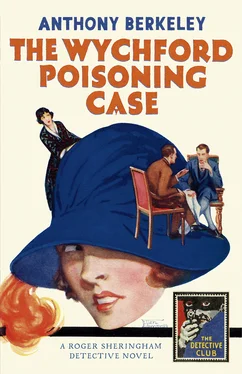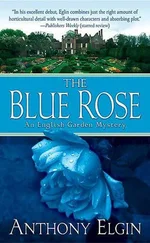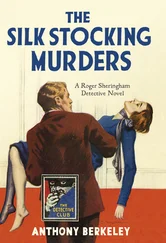‘THE DETECTIVE STORY CLUB is a clearing house for the best detective and mystery stories chosen for you by a select committee of experts. Only the most ingenious crime stories will be published under the THE DETECTIVE STORY CLUB imprint. A special distinguishing stamp appears on the wrapper and title page of every THE DETECTIVE STORY CLUB book—the Man with the Gun. Always look for the Man with the Gun when buying a Crime book.’
Wm. Collins Sons & Co. Ltd., 1929
Now the Man with the Gun is back in this series of COLLINS CRIME CLUB reprints, and with him the chance to experience the classic books that influenced the Golden Age of crime fiction.
Published by COLLINS CRIME CLUB
An imprint of HarperCollins Publishers Ltd
1 London Bridge Street
London SE1 9GF
www.harpercollins.co.uk
First published in Great Britain by The Crime Club by W. Collins Sons & Co. Ltd 1926
Copyright © Estate of Anthony Berkeley 1926
Introduction © Tony Medawar 2017
Cover design © HarperCollins Publishers Ltd 1926, 2017
A catalogue copy of this book is available from the British Library.
This novel is entirely a work of fiction. The names, characters and incidents portrayed in it are the work of the author’s imagination. Any resemblance to actual persons, living or dead, events or localities is entirely coincidental.
All rights reserved under International and Pan-American Copyright Conventions. By payment of the required fees, you have been granted the non-exclusive, non-transferable right to access and read the text of this e-book on screen. No part of this text may be reproduced, transmitted, down-loaded, decompiled, reverse engineered, or stored in or introduced into any information storage and retrieval system, in any form or by any means, whether electronic or mechanical, now known or hereinafter invented, without the express written permission of HarperCollins.
Source ISBN: 9780008216429
Ebook Edition © February 2017 ISBN: 9780008216436
Version: 2016-12-15
TO
E. M. DELAFIELD
MOST DELIGHTFUL OF WRITERS
MY DEAR ELIZABETH,
There is only one person to receive the dedication of the book which has grown out of those long criminological discussions of ours. You will recognise in it many of your own ideas, which I have unblushingly annexed; but I hope you will also recognise the attempt I have made to substitute for the materialism of the usual crime-puzzle of fiction those psychological values which are (as we have so often agreed) the basis of the universal interest in the far more absorbing criminological dramas of real life. In other words I have tried to write what might be described as a psychological detective story.
In any case I offer you the result as a small expression of my admiration of your work and of my gratitude for the gift of your friendship.
Contents
Cover
Title Page
Copyright
Dedication
Introduction
I. MARMALADE AND MURDER
II. STATING THE CASE
III. MR SHERINGHAM ASKS WHY
IV. ARRIVAL AT WYCHFORD
V. ALL ABOUT ARSENIC
VI. INTRODUCING MISS PUREFOY
VII. MOSTLY IRRELEVANT
VIII. TRIPLE ALLIANCE
IX. INTERVIEW WITH A HUMAN BURR
X. SHOCKING TREATMENT OF A LADY
XI. ENTIRELY FEMININE
XII. THE HUMAN ELEMENT
XIII. WHAT MRS BENTLEY SAID
XIV. INTERVIEW WITH A GREAT LADY
XV. MISS BLOWER RECEIVES
XVI. CONFERENCE AT AN IRONING-BOARD
XVII. MR ALLEN TALKS
XVIII. MR SHERINGHAM LECTURES ON ADULTERY
XIX. INTRODUCING BENTLEY BROTHERS
XX. MR SHERINGHAM SUMS UP
XXI. DOUBLE SCOTCH
XXII. ENTER ROMANCE
XXIII. FINAL DISCOVERIES
XXIV. VILLAINY UNMASKED
XXV. ULTIMA THULE
Footnote
The Detective Story Club
About the Publisher
ANTHONY BERKELEY COX—or Anthony Berkeley as he is best known—was born on 5 July, 1893 in Watford, a town near London. His father was a doctor and his mother was descended from the Earl of Monmouth, a courtier to Queen Elizabeth I. At school, Berkeley was what we would now call a high achiever—Head of House, prefect, Colour Sergeant in the Officer Training Corps and an expert marksman. In 1911, he left school to read Classics at University College, Oxford, but his university career was cut short by the First World War and, between 1914 and 1918, Berkeley served in France in the 7th Northamptonshire Regiment, reaching the rank of Lieutenant, and also in the Royal Air Force.
After the war, Berkeley spent a couple of years ‘trying to find out what nature had intended him to do in life’ before he discovered that he had the most extraordinary knack for writing comic stories for the many weekly magazines and newspapers that carried such fiction in the 1920s. Thankfully, Berkeley also decided to try his hand at something more serious, a detective mystery.
His first attempt, The Layton Court Mystery , was published anonymously in 1925 by Herbert Jenkins. The book marked the debut of Roger Sheringham, a man with more than a hint of his creator about him—in particular, like Berkeley, he was an Oxford man and his health had been compromised during the war. The Layton Court Mystery features a closed circle of suspects and a suitably unpleasant victim who is found dead in a locked room; the murderer’s identity comes as a devastating surprise. In dedicating the novel to his father, Berkeley explained that he had ‘tried to make the gentleman who eventually solves the mystery behave as nearly as possible as he might be expected to do in real life. That is to say, he is very far removed from a sphinx and he does make a mistake or two occasionally.’
Sheringham’s tendency to make ‘a mistake or two occasionally’ may very well have been inspired by E.C. Bentley’s famous novel Trent’s Last Case , published a dozen years earlier. Certainly, fallibility was to become something of a trademark for Roger Sheringham.
The Layton Court Mystery sold well and, enthused by the sales figures, Anthony Berkeley decided to focus on writing novels and to make Roger Sheringham the central figure of a series of mysteries. Sheringham’s second case, also published anonymously (the byline of the jacket was simply ‘By the author of The Layton Court Mystery ’), was The Wychford Poisoning Case .
The Wychford Poisoning Case (1926) is the rarest of Berkeley’s detective fiction. It was the first of his novels to be published by Collins but, unlike other Sheringham mysteries, has not until now been reissued, even in a paperback edition. It is unclear why this was but it has been suggested that it may have been because Berkeley felt acute embarrassment at a brief, irrelevant but bizarre scene in which an annoying young woman is subjected to corporal punishment. Whether or not the scene was meant ironically or simply as comic relief, it reads oddly today and, as with the casual anti-semitism that pollutes some Golden Age mysteries, leaves modern readers uncomfortable. Sexist aberrations aside, the novel is strong and the explanation of the poisoning is characteristically unexpected and outrageous. It is also noteworthy for being dedicated to Berkeley’s long-standing friend, the aristocratic Edmée Elizabeth Monica de la Pasture under her rather more prosaic pseudonym, E.M. Delafield.
Unlike The Layton Court Mystery , The Wychford Poisoning Case is based on a real-life murder—that of James Maybrick, a Liverpool businessman, in 1889. Like many other writers of the era, Berkeley had a deep interest in what has come to be called ‘true crime’, writing essays on various different cases over the years—indeed, The Wychford Poisoning Case would not be the only occasion on which Berkeley would draw on what he called ‘the far more absorbing criminological dramas of real life’. The Wychford Poisoning Case is also notable for the innovative consideration of psychology as a method of crime detection, pioneered some fifteen years earlier by Edwin Balmer and William MacHarg with their stories of Luther Trant. This was an approach that Anthony Berkeley would eventually perfect with Malice Aforethought (1931), in which he gave an ingenious study of a murderer, and in two other novels, all of which were published under a different pen name, Francis Iles.
Читать дальше











